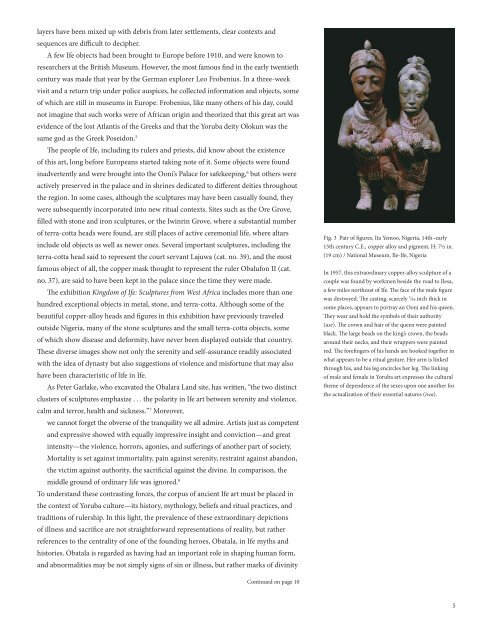The British Museum - Kingdom of Ife Sculptures from West Africa
Create successful ePaper yourself
Turn your PDF publications into a flip-book with our unique Google optimized e-Paper software.
layers have been mixed up with debris <strong>from</strong> later settlements, clear contexts and<br />
sequences are difficult to decipher.<br />
A few <strong>Ife</strong> objects had been brought to Europe before 1910, and were known to<br />
researchers at the <strong>British</strong> <strong>Museum</strong>. However, the most famous find in the early twentieth<br />
century was made that year by the German explorer Leo Frobenius. In a three-week<br />
visit and a return trip under police auspices, he collected information and objects, some<br />
<strong>of</strong> which are still in museums in Europe. Frobenius, like many others <strong>of</strong> his day, could<br />
not imagine that such works were <strong>of</strong> <strong>Africa</strong>n origin and theorized that this great art was<br />
evidence <strong>of</strong> the lost Atlantis <strong>of</strong> the Greeks and that the Yoruba deity Olokun was the<br />
same god as the Greek Poseidon. 5<br />
<strong>The</strong> people <strong>of</strong> <strong>Ife</strong>, including its rulers and priests, did know about the existence<br />
<strong>of</strong> this art, long before Europeans started taking note <strong>of</strong> it. Some objects were found<br />
inadvertently and were brought into the Ooni’s Palace for safekeeping, 6 but others were<br />
actively preserved in the palace and in shrines dedicated to different deities throughout<br />
the region. In some cases, although the sculptures may have been casually found, they<br />
were subsequently incorporated into new ritual contexts. Sites such as the Ore Grove,<br />
filled with stone and iron sculptures, or the Iwinrin Grove, where a substantial number<br />
<strong>of</strong> terra-cotta heads were found, are still places <strong>of</strong> active ceremonial life, where altars<br />
include old objects as well as newer ones. Several important sculptures, including the<br />
terra-cotta head said to represent the court servant Lajuwa (cat. no. 39), and the most<br />
famous object <strong>of</strong> all, the copper mask thought to represent the ruler Obalufon II (cat.<br />
no. 37), are said to have been kept in the palace since the time they were made.<br />
<strong>The</strong> exhibition <strong>Kingdom</strong> <strong>of</strong> <strong>Ife</strong>: <strong>Sculptures</strong> <strong>from</strong> <strong>West</strong> <strong>Africa</strong> includes more than one<br />
hundred exceptional objects in metal, stone, and terra-cotta. Although some <strong>of</strong> the<br />
beautiful copper-alloy heads and figures in this exhibition have previously traveled<br />
outside Nigeria, many <strong>of</strong> the stone sculptures and the small terra-cotta objects, some<br />
<strong>of</strong> which show disease and deformity, have never been displayed outside that country.<br />
<strong>The</strong>se diverse images show not only the serenity and self-assurance readily associated<br />
with the idea <strong>of</strong> dynasty but also suggestions <strong>of</strong> violence and misfortune that may also<br />
have been characteristic <strong>of</strong> life in <strong>Ife</strong>.<br />
As Peter Garlake, who excavated the Obalara Land site, has written, “the two distinct<br />
clusters <strong>of</strong> sculptures emphasize . . . the polarity in <strong>Ife</strong> art between serenity and violence,<br />
calm and terror, health and sickness.” 7 Moreover,<br />
we cannot forget the obverse <strong>of</strong> the tranquility we all admire. Artists just as competent<br />
and expressive showed with equally impressive insight and conviction—and great<br />
intensity—the violence, horrors, agonies, and sufferings <strong>of</strong> another part <strong>of</strong> society.<br />
Mortality is set against immortality, pain against serenity, restraint against abandon,<br />
the victim against authority, the sacrificial against the divine. In comparison, the<br />
Fig. 3 Pair <strong>of</strong> figures, Ita Yemoo, Nigeria, 14th–early<br />
15th century C.E., copper alloy and pigment, H: 7½ in.<br />
(19 cm) / National <strong>Museum</strong>, Ile-<strong>Ife</strong>, Nigeria<br />
In 1957, this extraordinary copper-alloy sculpture <strong>of</strong> a<br />
couple was found by workmen beside the road to Ilesa,<br />
a few miles northeast <strong>of</strong> <strong>Ife</strong>. <strong>The</strong> face <strong>of</strong> the male figure<br />
was destroyed. <strong>The</strong> casting, scarcely ¹⁄16 inch thick in<br />
some places, appears to portray an Ooni and his queen.<br />
<strong>The</strong>y wear and hold the symbols <strong>of</strong> their authority<br />
(ase). <strong>The</strong> crown and hair <strong>of</strong> the queen were painted<br />
black. <strong>The</strong> large beads on the king’s crown, the beads<br />
around their necks, and their wrappers were painted<br />
red. <strong>The</strong> forefingers <strong>of</strong> his hands are hooked together in<br />
what appears to be a ritual gesture. Her arm is linked<br />
through his, and his leg encircles her leg. <strong>The</strong> linking<br />
<strong>of</strong> male and female in Yoruba art expresses the cultural<br />
theme <strong>of</strong> dependence <strong>of</strong> the sexes upon one another for<br />
the actualization <strong>of</strong> their essential natures (iwa).<br />
middle ground <strong>of</strong> ordinary life was ignored. 8<br />
To understand these contrasting forces, the corpus <strong>of</strong> ancient <strong>Ife</strong> art must be placed in<br />
the context <strong>of</strong> Yoruba culture—its history, mythology, beliefs and ritual practices, and<br />
traditions <strong>of</strong> rulership. In this light, the prevalence <strong>of</strong> these extraordinary depictions<br />
<strong>of</strong> illness and sacrifice are not straightforward representations <strong>of</strong> reality, but rather<br />
references to the centrality <strong>of</strong> one <strong>of</strong> the founding heroes, Obatala, in <strong>Ife</strong> myths and<br />
histories. Obatala is regarded as having had an important role in shaping human form,<br />
and abnormalities may be not simply signs <strong>of</strong> sin or illness, but rather marks <strong>of</strong> divinity<br />
Continued on page 10<br />
5

















